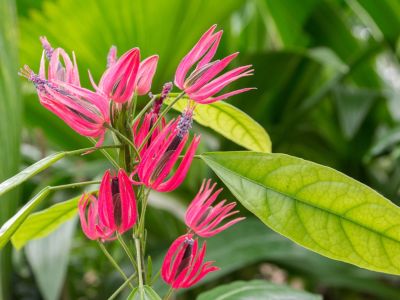What are Brazilian Candles?
Brightly colored, pink blooms with unique, long petals, or bracts, are vital characteristics of Pavonia Brazilian candles. What are Brazilian candles? They are a group of plants endemic to tropical South and Latin America. The exotic plants require warm temperatures and regular water. The intense flowers really bring the Brazilian feeling into a northern or western home where tropical touches evoke sultry hot nights and searing skies. As the name would suggest, these plants are decorated with fingered blooms whose petals resemble tapered candles. The actual flower is a deep purplish-blue and is covered in bright pink to red bracts, or modified leaves. The effect is quite startling and lends an air of carnival to the humdrum home interior. The plants can get 4- to 8-feet (1 to 2.5 m.) tall in natural settings but are more likely to achieve only 2 to 3 feet (0.5 to 1 m.) as a Brazilian candle houseplant. Leaves are lance-shaped, evergreen, and glossy on the upper side with a slightly furry texture on the underside. Flowers arise in spring and fall, but, in the home interior, they can be coaxed to bloom at any time of the year.
Growing a Brazilian Candle Houseplant
Pavonia Brazilian candles can be found at nursery centers and as a gift plant through florists. They can also be propagated from softwood cuttings in spring or from seed. The flowers become seed pods, which may be sown in flats. Brazilian candle plant needs temperatures of 60 to 80 degrees Fahrenheit (15-26 C.) for best growth but can survive temperatures down to 30 and 40 F. (-1 to 4 C). It will produce the best blooms in warm, humid conditions and can handle any light except full shade. Brighter lighting will increase blooming. Place the plant in a greenhouse, sunny window, or even a sunroom and it will likely bloom for you for many seasons.
Care of Brazilian Candles
Bring container plants outdoors in summer; they are attractive to bees and butterflies and other pollinating insects. Plant and repot them in a loam-based houseplant soil and keep the soil moderately moist all year round. Feed the plant with all-purpose plant food once per month, diluted in the water application. If you wish to encourage blooms, use a formula with a ratio higher in phosphorus, but be careful to leach the roots well after any such fertilizing to prevent root burn. Brazilian candle houseplants benefit from spritzing with water to increase humidity, especially in winter when heaters dry out the air. You can also set the pot on a saucer filled with pebbles and water, so evaporation will add moisture to the air. These plants have few disease issues and pest problems. They will last for many years and bloom almost consistently with good care.
